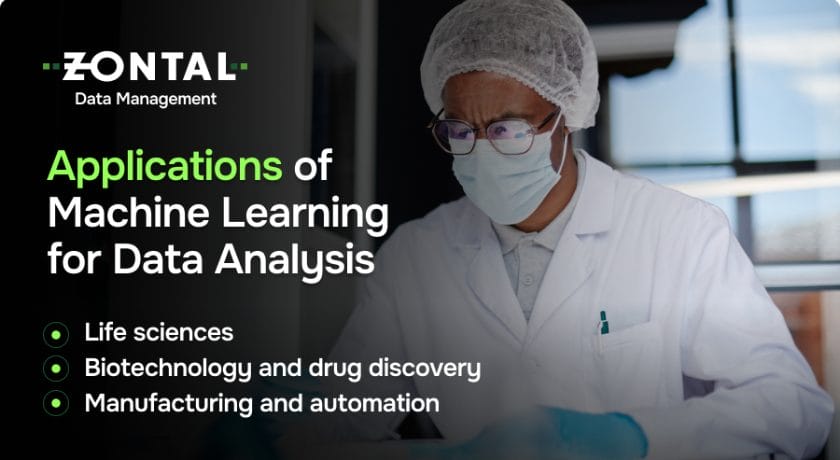Machine Learning in Data Analysis: Benefits & Challenges

Machine Learning Data Analysis: Key Takeaways
- Machine learning is transforming scientific data analysis, from handling large, complex datasets to improving accuracy and enabling predictive insights
- While the benefits of machine learning in data analysis are clear, challenges such as inconsistent data, model bias, and integration difficulties still require thoughtful oversight
- ZONTAL can help bridge the gap by standardizing, annotating, and integrating lab data across platforms
Machine learning is gaining serious momentum, with the global market expected to hit nearly $91 billion as of 2025.
For scientists, this number reflects the direction of research.
Whether it’s speeding up data analysis, improving accuracy, or uncovering patterns you’d never spot manually, machine learning in data analysis has quickly become a key part of life sciences, biotechnology, and beyond.
By the end of this guide, you’ll be able to:
- Understand the key benefits and challenges of using machine learning in data analysis
- Recognize three common ways machine learning is applied across scientific workflows
- See how ZONTAL can support and enhance your machine learning strategy
ZONTAL can help make your data machine-learning ready.
Core Benefits of Machine Learning in Data Analysis
Machine learning brings a lot to the table when it comes to data analysis, helping teams work faster, spot patterns more accurately, and uncover insights they might otherwise miss.
So, what makes machine learning such a game-changer for data analysis?
1. Ability To Handle Big Data
From high-throughput screens to instrument logs and LIMS entries, life science and biotech labs generate enormous amounts of data.
Machine learning helps make sense of it all by spotting patterns, trends, or anomalies that would be nearly impossible to catch manually.
2. Improve Accuracy and Efficiency
Machine learning takes on repetitive, complex tasks like peak picking in chromatography or identifying features in imaging data.
It speeds up analysis while improving accuracy and consistency across experiments, critical for scaling research and meeting regulatory standards.
3. Generate Predictive Insights
One of machine learning’s biggest strengths is its ability to predict what’s next.
It can forecast compound degradation, flag reaction issues, and detect process deviations, helping teams:
- Act early
- Optimize workflows
- Reduce development delays
A recent review of ML in bioprocessing highlights these capabilities across upstream, downstream, and formulation stages in biopharma manufacturing.

3 Common Applications of Machine Learning for Data Analysis
Let’s look at three ways machine learning is being put to work in data analysis across life sciences, biotech, and manufacturing.
1. Life Sciences
Machine learning in data analysis plays a key role in analyzing large-scale omics data, like genomics, proteomics, and metabolomics.
It helps researchers spot gene expression patterns, predict protein interactions, and map out regulatory networks, offering deeper insights into how biological systems function.
A 2024 study backs this up, showing how ML is being used across multi-omics datasets to uncover patterns and predict outcomes that would be difficult to detect manually.
2. Biotechnology and Drug Discovery
In R&D, machine learning accelerates molecule design, lead optimization, and screening.
Models predict binding affinities, assess compound properties, and generate novel candidates with targeted characteristics, helping teams focus resources on the most promising compounds.
3. Manufacturing and Automation
Machine learning in data analysis improves process control by analyzing historical and real-time data to detect deviations, optimize parameters, and predict equipment failures.
It supports visual inspection, inline quality checks, and adaptive control strategies, boosting efficiency, reducing waste, and ensuring consistent product quality.

Machine Learning vs. Traditional Data Analytics
Curious how machine learning stacks up against old-school data analysis?
Here’s a quick comparison:
| What It Does | Traditional Analytics | Machine Learning |
| How it works | Follows fixed rules and formulas set by analysts | Learns patterns directly from the data |
| Setup | You define the model up front | The model builds itself as it sees more data |
| Ideal for | Clean, structured, and predictable data | Large, complex, or messy datasets |
| Flexibility | Static; needs updates when things change | Dynamic; adapts as new data comes in |
| Main goal | Explains what happened | Predicts what’s likely to happen next |
| Human effort | High, you need to guide every step | Lower, machine learning can handle much of the heavy lifting on its own |
Need better control of your scientific data?
Common Challenges in Machine Learning for Data Analysis
Machine learning has a lot of potential, but it’s not without its hurdles.
Let’s take a look at some of the roadblocks that can get in the way of effective machine learning in data analysis.
1. Data Quality and Consistency
Machine learning relies on consistent, high-quality data.
But in life sciences and manufacturing, data often originates from a wide range of instruments, including:
- Mass spectrometers
- HPLCs
- Plate readers
- Bioreactors
Each system may output data in different file formats, with varying metadata standards and naming conventions.
For instance, a compound might be labeled differently across a LIMS and an ELN, or time-series data from a bioreactor may lack synchronized timestamps or units.
This inconsistency, combined with incomplete annotations or signal noise, can degrade model training, skew predictions, and make it difficult to reproduce results across experiments or sites.
2. Model Bias and Trust
When training data reflects narrow conditions, like results from a single lab setup or instrument, models can develop hidden biases.
This leads to predictions that don’t generalize across environments.
Add to that the “black box” nature of many ML models, and it becomes hard for scientists to validate or trust the outputs, especially in regulated or high-risk workflows.
3. System Integration and Scalability
Many labs rely on a patchwork of disconnected systems, like LIMS for sample tracking, ELNs for experimental notes, MES for production data, and custom spreadsheets or scripts to fill the gaps.
These systems rarely speak the same language, which makes it difficult to unify data streams or build a clean, continuous pipeline for machine learning.
Without integration, ML models are stuck working with isolated snapshots instead of real-time, end-to-end data, limiting their usefulness in broader R&D or manufacturing workflows.
4. Ethical Considerations
In life sciences and manufacturing, applying machine learning at scale raises ethical concerns beyond just privacy or bias.
Potential risks include:
- Misuse of experimental data
- Lack of transparency in automated decisions
- Misalignment with regulatory expectations
Accountability is another key issue. If a machine learning model drives a flawed formulation or flags a false process deviation, who’s responsible?
Over-relying on predictions without human oversight can lead to costly errors. Machine learning should support, not replace, scientific and operational judgment.
Looking for the Best Machine Learning Software for Data Analysis? ZONTAL’S Got You Covered
ZONTAL is a unified platform that captures and harmonizes data across instruments, ELNs, and LIMS, automatically annotating and organizing information to align with FAIR principles.
This streamlined approach minimizes manual work and ensures your data is ready for scalable, accurate machine learning, whether you’re:
- Building predictive models
- Automating analysis pipelines
- Accelerating discovery across complex scientific workflows
Ready to make your data machine learning ready?
Machine Learning in Data Analysis: FAQs
What is machine learning?
Machine learning uses algorithms that learn from patterns in data to make predictions, classify information, or automate decisions.
In laboratory settings, it’s applied to large, complex datasets generated by experiments, instruments, and scientific research.
What is data analysis?
Data analysis is the process of turning raw data into useful insights.
While the exact steps can vary depending on your goals and the type of data you’re working with, most data analysis workflows follow a similar structure:
- Clean the data: Before you can learn anything from your data, you need to make sure it’s accurate. That means checking that it comes from reliable sources, fixing any formatting issues, and removing duplicates or errors that could skew your results.
- Transform the data: Once it’s clean, the next step is getting the data into a format that’s easier to work with. This might mean changing file types, reordering fields like dates or currencies, or standardizing how information is structured, so it’s consistent across the board.
- Leverage or store the data: After transformation, you can either dive into analysis right away or move the data into a warehouse for secure, organized storage, making it easier to access and search when needed.
How is machine learning used in data analytics?
Machine learning helps analyze large, complex datasets by identifying patterns, making predictions, and automating data processing.
In fields like life sciences and manufacturing, it transforms experimental, instrument, and production data into actionable insights.
It also accelerates omics data analysis, automates imaging workflows, predicts compound behavior, and supports real-time monitoring of manufacturing, driving smarter decisions and greater efficiency.
What are the benefits of using ML for data analysis?
- Scalability: ML can handle massive volumes of data from various sources, well beyond the limits of manual or traditional analysis.
- Speed and automation: It takes over repetitive tasks like data cleaning, peak detection, and classification, saving time and letting experts focus on higher-value work.
- Greater accuracy: By applying consistent logic across datasets, ML reduces human error and improves reliability.
- Predictive insights: ML can forecast outcomes like process deviations or stability issues, helping teams take action before problems arise.
- Deeper discovery: It uncovers patterns and relationships that aren’t immediately obvious, opening the door to new findings and better process optimization.
Not sure where to start with machine learning in data analysis?
 >
> 

